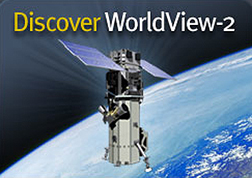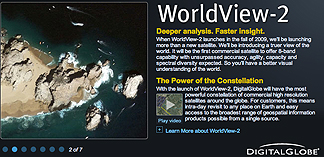 As a result of the delay of the Delta II launch, the DigitalGlobe Satellite launch date has been impacted.
As a result of the delay of the Delta II launch, the DigitalGlobe Satellite launch date has been impacted. DigitalGlobe [NYSE: DGI], a global provider of commercial high-resolution, world-imagery products and services for defense and intelligence, civil government, and commercial clients, today
announced that the launch date for WorldView-2, the company’s most recent high-resolution, remote-sensing satellite, has been delayed as a result of the delayed launch of the mission immediately preceding WorldView-2. WorldView-2 will not launch on October 6, 2009 and is
currently subject to day-to-day rescheduling until the Delta II launch ahead of WorldView-2 is completed. The company does not believe at this point that any delays will be significant.
WorldView-1 and WorldView-2 are the first commercial satellites to have control moment gyroscopes (CMGs). This high-performance technology provides acceleration up to 10X that of other attitude control actuators and improves both maneuvering and targeting capability. With the CMGs, slew time is reduced from over 60 seconds to only 9 seconds to cover 300km. This means WorldView-2 will be able to rapidly swing precisely from one target to another, allowing extensive imaging of many targets, as well as stereo, in a single orbital pass.
 With its improved agility, WorldView-2 will be able to act like a paintbrush, sweeping back and forth to collect very large areas of multispectral imagery in a single pass. WorldView-2 alone will be able to collect nearly 1 million sq km every day, doubling the collection capacity of our constellation to nearly 2 million sq km per day.
With its improved agility, WorldView-2 will be able to act like a paintbrush, sweeping back and forth to collect very large areas of multispectral imagery in a single pass. WorldView-2 alone will be able to collect nearly 1 million sq km every day, doubling the collection capacity of our constellation to nearly 2 million sq km per day. And the combination of WorldView-2’s increased agility and high altitude enables it to typically revisit any place on earth in 1.1 days. When added to DigitalGllobe's constellation, revisit time drops below one day and never exceeds two days, providing the most same-day passes of any commercial high resolution satellite constellation.
WorldView-2’s advanced geopositional technology is allowing for significant improvements in accuracy as well.
The accuracy specification has been tightened to 6.5m CE90 right off the satellite, meaning no processing, no elevation model and no ground control. With WorldView-1, and anticipated for WorldView-2, the measured accuracy is coming in at a remarkable 4.1m CE90.
WorldView-2 will provide the only high resolution 8-band multispectral commercial satellite imagery available. Along with the four typical multispectral bands: Blue (450-510), Green (510-580), Red (630-690) and NearIR (770-895), WorldView-2 is introducing the following new color bands for enhanced multispectral analysis.
Topical Tags :
Regional Tags :

